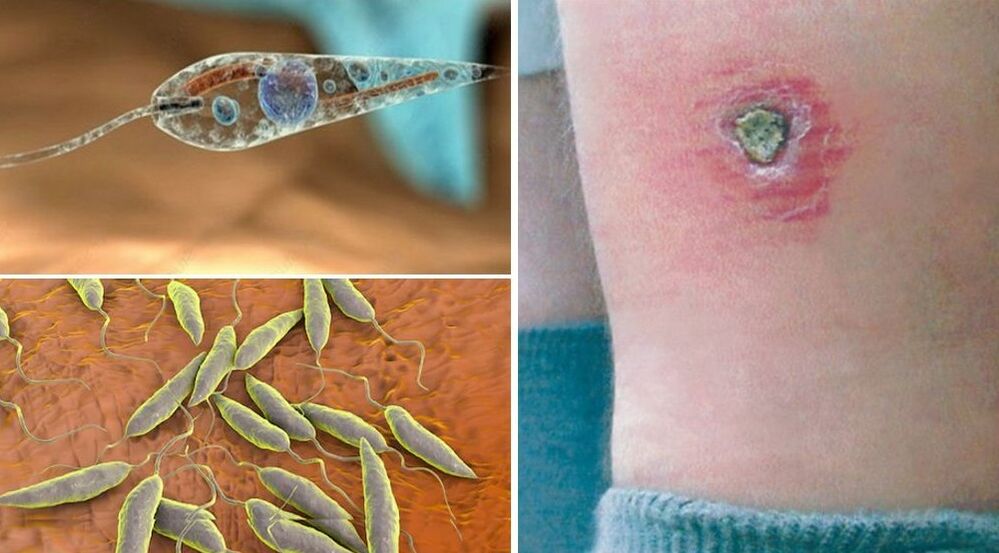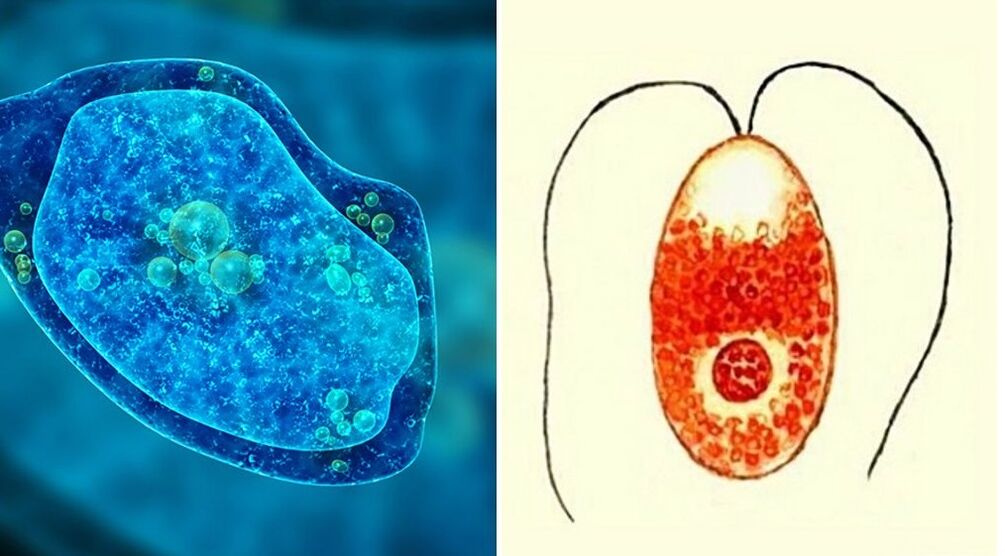Protozoan parasites in humans are the causative agents of protozoan infections (or protozoa). These diseases are contagious, threatening serious complications and consequences. Therefore, protozoan requires timely diagnosis, accurate identification of the pathogen and proper treatment.
What are protozoan parasites
This is a group of unicellular microorganisms that are unable to generate nutrients independently. In the process of life, they use other creatures, causing them serious diseases. The most common human protozoan parasites are listed below:
- flagella - giardia, leishmania, trichomonas, trypanosoma;
- sarkodal - dysenteric ameba;
- ciliates - bursaria, balantidia;
- sporozoanet - plasmodium malarial, coccidia, piroplasma.
trypanosomes
The simplest parasite whose life cycle develops in the body of an antelope or an infected person. Carriers are tse-tse flies, which, when bitten by a person, inject saliva with protozoan into his skin.
On a note!
For the development of the disease (African trypanosomiasis or sleep disease), the introduction of about 400 trypanosomes is necessary. With the bite of a tse-tse fly, up to half a million individuals of the parasite fall.
Characteristics of parasitism and disease:
- trypanosomes initially circulate in the blood of an infected person, causing trypanides on the skin (swelling of the face, eyelids), fever up to 40 ° C, swelling of the lymph nodes;
- then unicellular parasites migrate to the cerebrospinal fluid, causing drowsiness, iridocycle, chronic fatigue, lethargy, impaired speech, coordination;
- the advanced form of trypanosomiasis is characterized by limb convulsions, epileptic seizures, nervous and physical fatigue, respiratory paralysis, coma, and death.
Romanovsky-Giemsa test, immunofluorescence reaction, enzyme analysis (ELISA), lymph node perforation are used for the diagnosis of trypanosomiasis. Confirmation of the diagnosis is often performed by inserting the blood of a sick person into laboratory pigs. Treatment of sleep sickness involves taking special medications. In the absence of therapy with a high degree of probability, a fatal outcome of the patient is possible.
lamblia
Microscopic protozoa (synonyms - giardia or giardia) with four pairs of flagella are full-cycle parasites in the human body. Under certain conditions, they cause giardiasis disease. Giardia are attached to the wall of the small intestine with a large sucker, often placed in the ducts of the liver, gallbladder and other internal organs.
On a note!
Protozoa infection occurs with food, water, in unsanitary conditions. Embryonic Giardia cysts remain invasive in the environment for a long time (up to 3 months in freshwater, up to 4 months in wastewater). Diagnosis of protozoa is performed by microscopy of cysts and adults in feces, blood, detection of antibodies in the ELISA study.
Leishmania
These flagella protozoa cause leishmaniasis, which is common in tropical and subtropical countries. The infection occurs in a contagious way - when bitten by the saliva of blood-sucking insects, animals (dogs, earth squirrels). Mosquitoes, gnats, flies, ticks can be carriers. There are two types of leishmaniasis in humans:
- skin and mucocutaneous form (pendinskaya ulcer) - leishmania lives and multiplies on human skin, causing inflammation, swelling, ulcers, trophic ulcers, damage to the respiratory tract;
- visceral form - leishmania is located in the internal organs (spleen, liver, lungs, heart).
A characteristic sign of cutaneous leishmaniasis is the formation of brown nodules (leishmanioma) at the site of insect bite. They are then replaced by round, hard-to-heal ulcers, with purulent exudates. The disease lasts 1-2 years, leaving marks on the skin. In the visceral form, leishmaniasis causes dysfunction of the adrenal glands, kidneys, liver and spleen. When leishmaniasis is diagnosed, they are found in the bone marrow, lymph nodes, skin abrasions, and blood.

On a note!
Treatment of leishmaniasis includes quarantine measures, patient isolation and medication.
Trichomonas
These are the simplest parasites of the human internal environment, which are transmitted sexually, through family contact or as a result of maternal infection from mother to child. There are oral, intestinal and urogenital varieties of Trichomonas. Protozoa are the causative agents of trichomoniasis / trichomoniasis. Urogenital trichomoniasis of the genitourinary system is widespread. The chronic form of the disease threatens with impotence and persistent infertility. Characteristics of Trichomonas parasitism:
- body size - up to 18 microns, moves rapidly due to mobile flagella;
- drug resistant, determining the chronic course of trichomoniasis;
- die quickly in the environment, in the air, under direct sunlight;
- stay long on wet cloths, sponges, towels, soap dishes;
- frequent infection during sexual intercourse of the vaginal, oral-vaginal type;
- Trichomonas contribute to the development of candidiasis, vulvitis, chlamydia, gonorrhea, cystitis.
The diagnosis of trichomoniasis involves the detection of Trichomonas in tampons from the genitals. Treatment includes the use of drugs, treatment with antiseptics. Therapy is performed on both partners to avoid relapses. Prevention of urogenital trichomoniasis includes recommended measures for all sexually transmitted diseases.
dysenteric ameba
This sarcoma microorganism is a parasite that causes dangerous diseases in humans. There are two forms of dysentery amoebiasis - intestinal and extraintestinal (hepatic or pulmonary). The disease begins 7-10 days after infection with symptoms - bloody diarrhea, fever, vomiting.
If left untreated, the consequences of amoebiasis develop - dehydration, exhaustion, weakness, internal bleeding, liver abscess. Infection most often occurs by the oral-fecal route. Carriers of amoebic cysts can be insects - flies, flies. During diagnosis, tissue forms of protozoa are found in the feces. Treatment of amoebiasis is inpatient, with the use of antibiotics.

Plasmodium and malaria
The representative of the simplest sporozoans, the causative agent of a dangerous disease - malaria. The human body serves as an incubator where the parasite life cycle takes place. Characteristics of parasitism:
- plasmodium sporozoite infection occurs when bitten by a malaria mosquito;
- sporozoites enter the bloodstream through the saliva of an infected insect;
- sporozoites settle in the liver, penetrate into its cells (hepatocytes);
- here merozoites are formed by mitotic replication;
- when hepatocytes are destroyed, merozoites penetrate the erythrocytes;
- from merozoites as a result of the sexual cycle, gametocytes are formed;
- a mosquito becomes infected with gametocytes when bitten by an infected person;
- in the body of mosquitoes, gametocytes pass into oocysts and then into sporozoites;
- a mosquito infects a healthy person and the cycle repeats.
Erythrocyte destruction and release of gametocytes into the bloodstream is associated with people with fever, vomiting, anemia, convulsions, and joint pain. In severe cases, the risk of death increases. Malaria often takes on a relapsing character with stages of exacerbation and rest. Different protozoa cause tropical, three-day and four-day malaria. The main therapeutic and diagnostic agent is quinine - natural from cinchona or artificially synthesized.
Infusoria balantidia coli
This causative agent of the disease balantidia (or infusive dysentery) lives in the colon, causing bleeding ulcers in its walls. Protozoa infection occurs from pets, the main carrier is pig. Characteristics of anatomy and parasitism:
- the body of the balantidia is ovate with a dense and strong shell (pelicle);
- on the surface there are many eyelashes that serve for movement;
- the sexual form of the parasite is necessary for reproduction by simple division;
- asexual form (cyst) enters the environment with feces;
- The route of human infection with cysts is oral-fecal.
Displacement of protozoa in the intestines is associated in people with headaches, vomiting, and indigestion. The acute phase of balantidiasis is manifested by a feverish state, signs of severe intoxication, loose stools with blood clots. In the absence of timely treatment, a fatal outcome is possible.
Toxoplasma gondii
Crescent-shaped microscopic microscopic spore protozoa are widespread in the environment. They are the causative agents of the disease - toxoplasmosis. In healthy people, ingested pests are destroyed by immune cells. Characteristics of the disease caused by protozoan parasites in humans:
- often toxoplasmosis is asymptomatic, after recovery, immunity develops;
- the parasite affects the organs of vision, reproductive system, nervous, lymphatic, liver, spleen;
- during pregnancy, toxoplasmosis causes severe congenital pathologies in the fetus or its death;
- the acute form continues with convulsions, paralysis, liver hypertrophy, heart problems;
- in a chronic course, heart dysfunctions, damage to the visual organs are possible.
The main protozoa hosts are cats. In their body, large Toxoplasma colonies are formed by oocysts. Humans are intermediate hosts, infected through food, contact-family or oral-fecal routes.






































